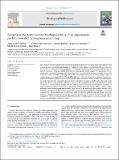Por favor, use este identificador para citar o enlazar a este item:
http://hdl.handle.net/10261/252764COMPARTIR / EXPORTAR:
 SHARE SHARE
 CORE
BASE CORE
BASE
|
|
| Visualizar otros formatos: MARC | Dublin Core | RDF | ORE | MODS | METS | DIDL | DATACITE | |

| Título: | Foraging in the Anthropocene: Feeding plasticity of an opportunistic predator revealed by long term monitoring |
Autor: | Ouled-Cheikh, Jazel CSIC ORCID; Morera-Pujol, Virginia; Bahillo, Alberto; Ramírez Benítez, Francisco CSIC ORCID CVN ; Cerdà-Cuéllar, M.; Ramos, Raül | Palabras clave: | Dietary assessments Longitudinal studies Larus michahellis Stable isotope analysis Trophic plasticity Yellow-legged gull |
Fecha de publicación: | oct-2021 | Editor: | Elsevier | Citación: | Ecological Indicators 129: 107943 (2021) | Resumen: | For centuries, human activities have altered the population dynamics of wildlife. New anthropogenic food sources provide a predictable and abundant food supply that often induces very significant changes in the size, distribution, and behaviour of many populations, with ultimate consequences on the structure and functioning of natural ecosystems. Here, we combine historical and contemporary feather samples of a population of a superabundant, opportunistic predator, the yellow-legged gull Larus michahellis, to assess its trophic ecology and relate it to human activities in the long term. Dietary assessments were based on stable isotope analysis of carbon, nitrogen, and sulphur (δ13C, δ15N and δ34S), and were conducted through three end-point (marine prey, waste from landfills-slaughterhouses, and terrestrial invertebrates) Bayesian mixing models. Our results suggest that gulls’ diet showed a progressive decrease in the consumption of marine prey throughout the most recent period (late 20th century onwards), linked to an increase in the consumption of meat waste and small terrestrial invertebrates. Reported dietary changes over the sampling period correlated positively with the availability of marine resources around the breeding area. We provide evidence suggesting that the ability of gulls to exploit efficiently diverse anthropogenic food subsidies likely resulted in the exponential demographic increase of this population throughout the 20th century. In addition, current regulations affecting the availability of these food resources (e.g., fishing discards and landfill waste) likely reversed this trend over the last decade. Long-term evidence of population trophic plasticity, like the one we present here, is essential to implement and support management and conservation actions that limit the availability of anthropogenic resources, especially when it comes to superabundant, problematic species | Descripción: | 10 pages, 4 figures, 4 tables, supplementary data https://doi.org/10.1016/j.ecolind.2021.107943 | Versión del editor: | https://doi.org/10.1016/j.ecolind.2021.107943 | URI: | http://hdl.handle.net/10261/252764 | DOI: | 10.1016/j.ecolind.2021.107943 | ISSN: | 1470-160X |
| Aparece en las colecciones: | (ICM) Artículos |
Ficheros en este ítem:
| Fichero | Descripción | Tamaño | Formato | |
|---|---|---|---|---|
| Ouled_et_al_2021.pdf | 2,76 MB | Adobe PDF |  Visualizar/Abrir | |
| Ouled_et_al_2021_suppl.docx | 2,71 MB | Microsoft Word XML | Visualizar/Abrir |
CORE Recommender
SCOPUSTM
Citations
3
checked on 12-may-2024
WEB OF SCIENCETM
Citations
3
checked on 26-feb-2024
Page view(s)
78
checked on 15-may-2024
Download(s)
81
checked on 15-may-2024
Google ScholarTM
Check
Altmetric
Altmetric
Este item está licenciado bajo una Licencia Creative Commons

